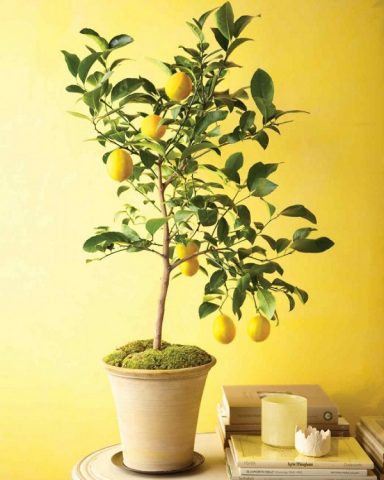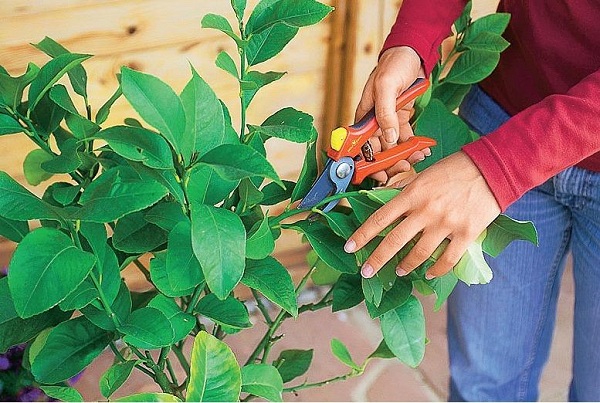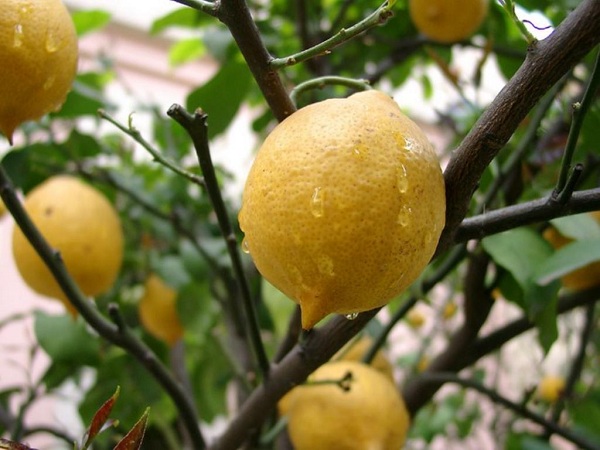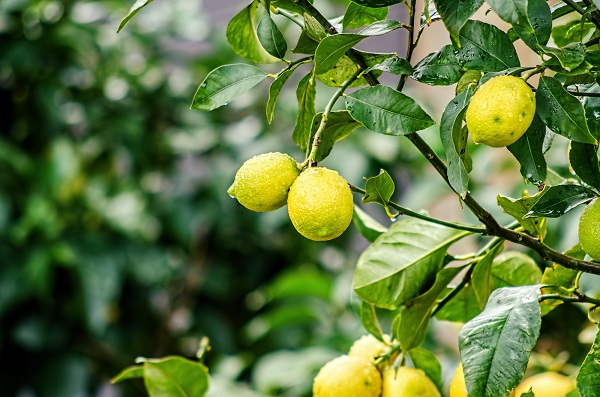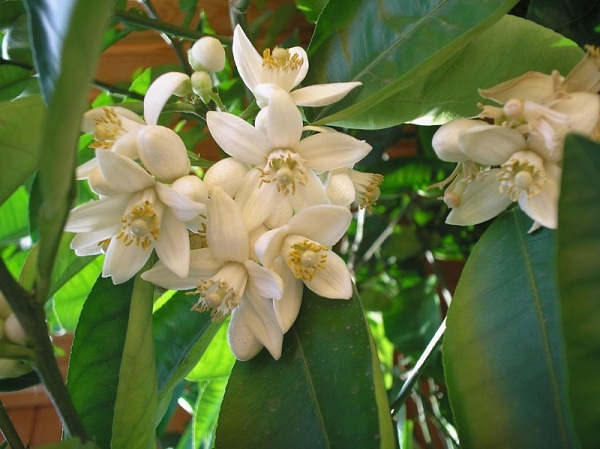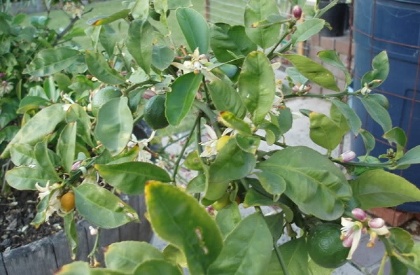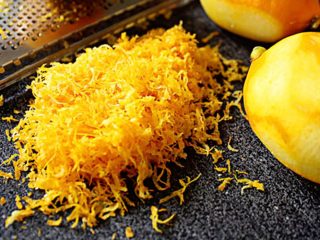Content
- 1 How to properly care for a lemon tree
- 2 Creating optimal conditions
- 3 How to trim a lemon
- 4 How to feed a lemon
- 5 Features of caring for indoor lemon in some cases
- 5.1 How to properly care for lemons after purchasing them in a store
- 5.2 How to care for a lemon in a pot in winter
- 5.3 How to care for homemade lemons during flowering
- 5.4 How to care for lemons at home during the fruiting period
- 5.5 How to care for a lemon tree in a pot after fruiting
- 5.6 Features of caring for decorative lemons
- 6 How to care for a lemon tree in case of emergency
- 7 Conclusion
You need to carefully care for a lemon or decorative tree. Indoor citrus trees are demanding on the microclimate, soil and environment. Back in the 12th century, Indians began to grow lemons at home and use them in medicine, home life, and eat them. Bright yellow fruits with a delicate aroma make the home more cozy and comfortable.
How to properly care for a lemon tree
Growing citrus trees is quite troublesome, but citrus is particularly unpretentious. A young plant is purchased in gardening stores or people try to grow a tree from a seed or a rooted cutting.If a seed has been planted, the first fruits will appear in 7-8 years, and a purchased tree will begin to bear fruit in 3-4 years. Initially grown lemons at home will rarely get sick and bear fruit abundantly for a long time. Over the entire period of life, the plant can grow up to 1-1.5 m.
In the early stages of growth, it is necessary to form a crown and trim the upper branches, which promotes the formation of new foliage. The plant will feel comfortable in a well-lit room with natural light. Moving the tree, sharply lifting it, placing it or moving it is highly not recommended. This leads to rapid shedding of foliage or buds. If there is abundant flowering, you need to remove empty flowers that do not have stamens. Also, too many fruits will deplete the tree. On a fruiting branch, 10 to 15 mature leaves are allowed, which feed the fruits until ripening.
A decorative lemon tree in a pot is not placed on the floor, because the roots of the plant are sensitive to temperature. The pot is placed at the level of the window sill or so that there is at least 2 m left to the ceiling. Caring for tinted citrus differs from fruit-bearing ones in that pruning can be omitted. The tree reaches 60-70 cm and stops growing, then begins to bear fruit like an ordinary lemon. The fruits differ in size, taste and thickness of the peel. They can be kept on branches and the peel will not become thick. After full ripening, the fruits either fall off on their own or are cut off. Caring for an ordinary fruit-bearing citrus tree is more meticulous.
Creating optimal conditions
Creating comfortable conditions and proper care of lemons guarantee tasty and juicy fruits, as well as a healthy plant. The tree loves warmth and light, so lemons are grown on stands in a room with a lot of light or on window sills on the south side of the apartment. With diffused light, the tree will develop quickly, but in the summer, the sun's rays are dangerous for the plant, so you need to limit the time the citrus tree stays in the light to 3-4 hours. In winter, the plant needs more light, so the room should have regular lighting for up to 10-12 hours.
When growing and caring for lemons at home, you need to observe the temperature regime, maintaining a constant microclimate in the room from + 15 ° C to + 25 ° C. When the plant begins to bloom, the room is ventilated; the temperature is allowed to drop to + 10 °C. A sudden change in climate should not be allowed, otherwise the foliage will fall off. After winter or summer ventilation, the tree is left for 20-30 minutes in a cool place so that the lemon acclimatizes. In winter, the colored tree is grown in the coolest and brightest room, providing maximum non-interference in the flowering process.
At temperatures from + 7 °C and below, the plant goes into hibernation and can independently stop the growing season.With the onset of spring, the tree is taken outside at a temperature of + 12 ° C to + 15 ° C, when the earth begins to warm up completely, fumes are released. At this time, the lemon can be watered only once a day. The tree is placed in shade or partial shade so that the process of getting used to sunlight goes well. Citrus is brought into the room with the first signs of a drop in temperature. With the onset of autumn, the ornamental tree is grown on the veranda until the first cold weather, then transferred to a cool room.
The air in the room should be regularly humidified 1-2 times a day using a spray bottle. Optimal humidity is up to 60-70%. In addition to air, you need to spray the leaves of the tree with water; wiping all the foliage with plain water is allowed. In case of any stains or pests, wipe each sheet with a damp, soapy cloth. The solution should be very weak so as not to harm the plant, but only to disinfect it.
How to trim a lemon
Gardeners and gardeners disagree on when to prune citrus or shape the crown. Caring for a lemon tree at home by pruning guarantees rapid development of the crown and accelerated fruiting. Tree pruning is done in the spring before buds appear, in the fall before the first rains and in winter during hibernation so that the tree bears fruit well the next season. The first shaping of a purchased plant is done in the first year of life with home care, when the main trunk grows 25-30 cm. The top of the stem is pinched or cut off so that the plant begins to branch.
Before the beginning of spring in the second year of development, the lemon is cut back by 10-15 cm so that 5-6 shoots remain on the trunk, which will branch in different directions.There are cases when one or more buds grow from the main shoot; in the first case, 1 bud is cut off; in the second, the strongest shoot is left, removing the rest. All old annual shoots are removed to the base. The formation of the crown of a decorative lemon is accelerated by pruning young growing branches. The young plant can be placed on the windowsill. You can care for your lemon before the first flowering by organizing regular watering, timely fertilizing and pruning.
The main formative pruning is carried out in the spring in March or April. Shoots that thicken the crown must be removed or the top of the shoot must be pinched by 15-20 cm, then the branch will bear fruit. Sanitary pruning is carried out seasonally. This care will prevent the lemon from getting sick or withering. Dry, diseased, weak branches are pruned back to healthy shoot tissue. Rejuvenating care and shaping of the tree is done after 5-10 years of lemon growth. As soon as the above-zero temperature does not change much, cut off all the lower branches from the lemon and trim the top to the chosen shape. Before pruning, tools are disinfected with alcohol, boiling water or a diluted solution of manganese.
The care and fruiting of lemons at home can be regulated even before flowering by trimming the shoots and flower stalks. In winter, up to 10-12 strong flowers are left on the tree. It is better to leave up to 7 peduncles on a young tree, then increase the number of ovaries left every year.
How to feed a lemon
During care, it is useful to feed citrus with saltpeter at any time of the year. It relieves lemon or regular lemon from nitrogen starvation.For 10 liters of water there is 40-50 g of nitrate, sometimes potassium fertilizer is added. Mineral fertilizing is done with the onset of the first cold weather and in the middle of flowering. Superphosphates replace the lack of phosphorus in the soil and take a long time to dissolve, so they are added to the soil 2 times a year. In order for phosphates to act quickly, the raw material is boiled until completely dissolved, then diluted in 10 liters of water. The solution must cool. Next, water the lemon 2 times a day.
Organic fertilizers for lemon include mullein and chicken manure. Wood ash can replace mineral fertilizers. 500 g of dry raw material is poured into 10 liters of water and left for 2 weeks to ferment. Before each watering, 500 ml of the mixture is diluted with water and watered over the citrus. Fertilizer is applied during watering or sprayed with a solution from a spray bottle.
Lemon is looked after and fertilized:
- During the period of initial growth. Every 2 weeks the plant is fed with nitrogen fertilizer or a small amount of nitrate.
- At the time of flowering. Potassium, phosphorus or organic additives are added to the soil.
- During fruiting. Citrus is fed with organic matter and minerals alternately.
- During hibernation. The plant is fed with mineral supplements once per winter season, the dosage is reduced by 2 times.
The soil should always be moist. Overdried soil during fertilizing with liquid solutions will stop the development of the plant and it will die. In the fall, before hibernation, lemon is often poured with strong tea without additives.
Features of caring for indoor lemon in some cases
Indoor, decorative and purchased trees require different types of care. If a homemade lemon cannot be seriously injured, and a decorative one needs to be pruned often, then a purchased one is unpretentious in all phases of growth.
How to properly care for lemons after purchasing them in a store
It is recommended to buy citrus in gardening stores in the spring or summer season, when the temperature is always above zero, then the lemon tree at home will quickly acclimatize. Home care involves careful control of soil moisture and microclimate. The soil should not be allowed to dry out; watering is carried out 1-2 times a day. Pruning is carried out at the beginning of autumn and in mid-spring. Fertilizing is done every month, alternating mineral and organic supplements.
How to care for a lemon in a pot in winter
Winter care for indoor lemon in a pot affects the subsequent fruiting of the plant. The room temperature should not rise above + 7-10 °C. Water the plant once a day with water at room temperature. Once a week, mineral supplements are combined with watering. During the period of winter care there should be no active growth, otherwise pruning is carried out. It is necessary to provide constant lighting or expose the citrus to the sun from dawn to sunset.
How to care for homemade lemons during flowering
During the flowering period, lemon care should be carried out so that the plant does not drop its flowers or foliage due to disturbance. On a branch with a large number of flowers leave 2-3 pieces. Young trees should not be allowed to bloom; only after the crown has fully developed, a small number of flowers are left. If not properly cared for during the flowering period, the leaves may become rusty. Watering is carried out every day.The duration of daylight hours for lemon should last from 8 to 10 hours. Fertilizing is done with bird droppings or a diluted solution of manure and water.
How to care for lemons at home during the fruiting period
During the fruiting period, it is better not to touch the lemon at all and take care of it carefully. If rearranged carelessly, the plant may drop its fruits. During care, you need to maintain a constant microclimate or ensure a regular temperature in the room. Optimal environment for good fruit development: + 20 °C. Every month during the fruiting period, the soil is fertilized with organic additives. If the plant is young, then fertilize the lemon once every 3 months until the first flowering. To obtain a large and juicy harvest, replace ordinary water with an infusion of eggshells, which is used to water the plant once a week.
How to care for a lemon tree in a pot after fruiting
The fruits are cut off as they ripen, along with the stalk. The egg solution is again replaced with plain water. You need to water the plant in the morning once a day. The light regime must be extended to 10 hours, and the plant should be exposed to light. Some gardeners immediately prune and switch to winter care. After fruiting, the plant rests, so the roots are fed once a week with an organic or mineral complex of additives.
Features of caring for decorative lemons
Due to the hybridity of the varieties, ornamental lemons develop rapidly in growth, so there are some peculiarities in caring for the plant. After 3-4 months of cultivation, the first pruning is carried out, then it is carried out every season. Such care will ensure a high-quality harvest, and the citrus will rarely get sick.
Watering is carried out every day, the light regime should not last more than 10 hours. The temperature in the room should not exceed + 18 °C, otherwise the soil will dry out quickly. Regular care of the lemon when it blooms is suspended; during this period the plant should be at rest. Decorative citrus is sprayed daily from a spray bottle. The tree tolerates moving and transplanting well. Over the entire period of life, the lemon is replanted 2-3 times and rejuvenating pruning is carried out every spring.
How to care for a lemon tree in case of emergency
Emergency cases mean dry soil, disease or sudden reactions of the plant to the environment. A lemon that needs frequent watering rolls its leaves into tubes, drops them, or the leaves begin to turn yellow and become covered with rust. From overwatering, a tree can suddenly lose its leaves, then it is better not to water the plant for 2-3 days, then reduce the frequency of watering.
It happens that citrus freezes. Caring for a frozen lemon tree is carried out gradually and carefully. You can revive the plant by insulating the trunk with gauze, which is folded in 3-4 layers. Daylight hours for a frozen plant are extended to 15-18 hours. The temperature in the room should be from + 15 ° C to + 18. Frozen lower branches are completely pruned. The lemon will re-acclimate once new buds appear.
Conclusion
Caring for a lemon is not as difficult as it seems. Gradually, the care process will become a habit, and the plant will delight the owner with a neat appearance and nutritious fruits.If you follow all the recommendations for caring for a lemon tree, you can not expect a sudden negative reaction to the microclimate or diseases.
